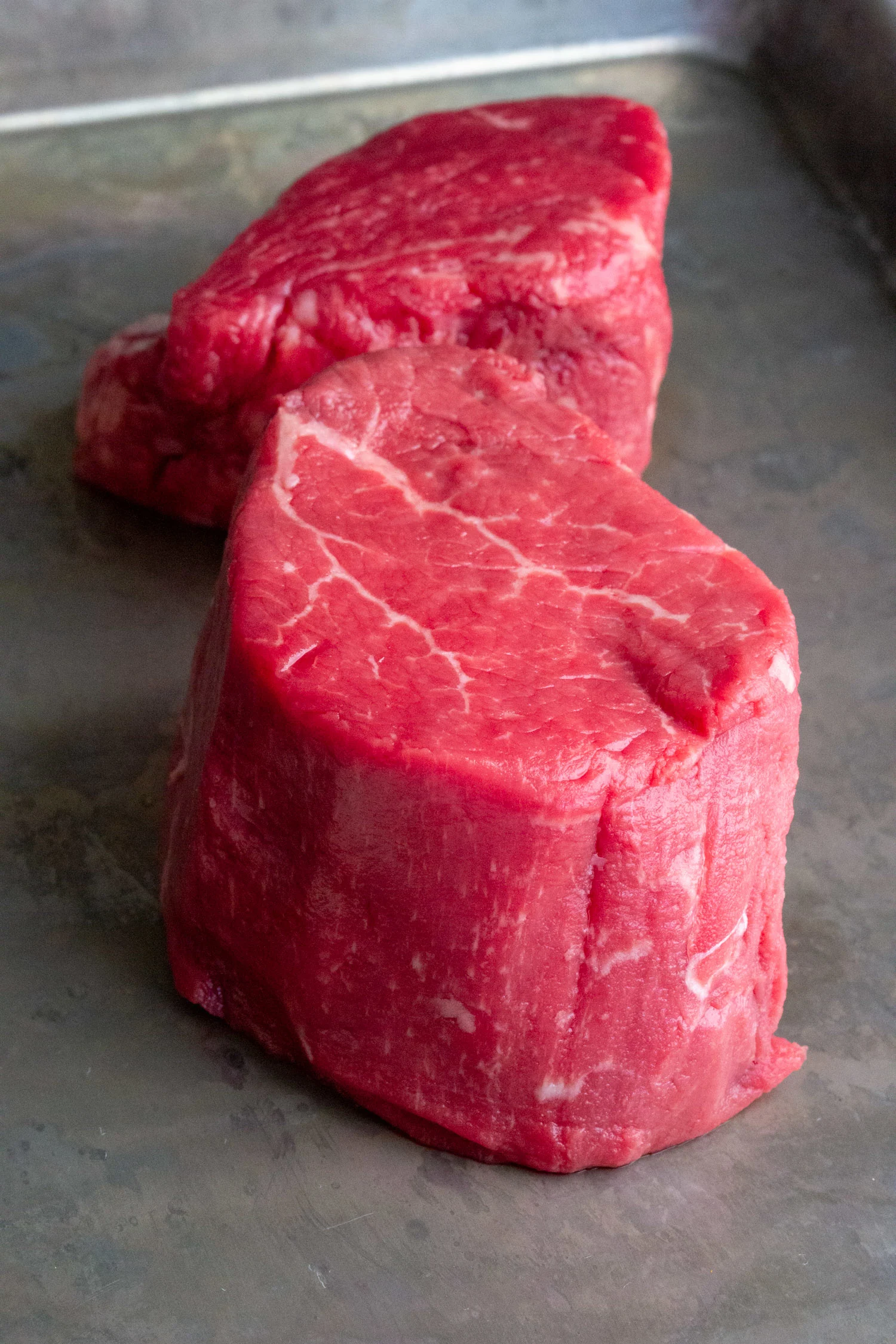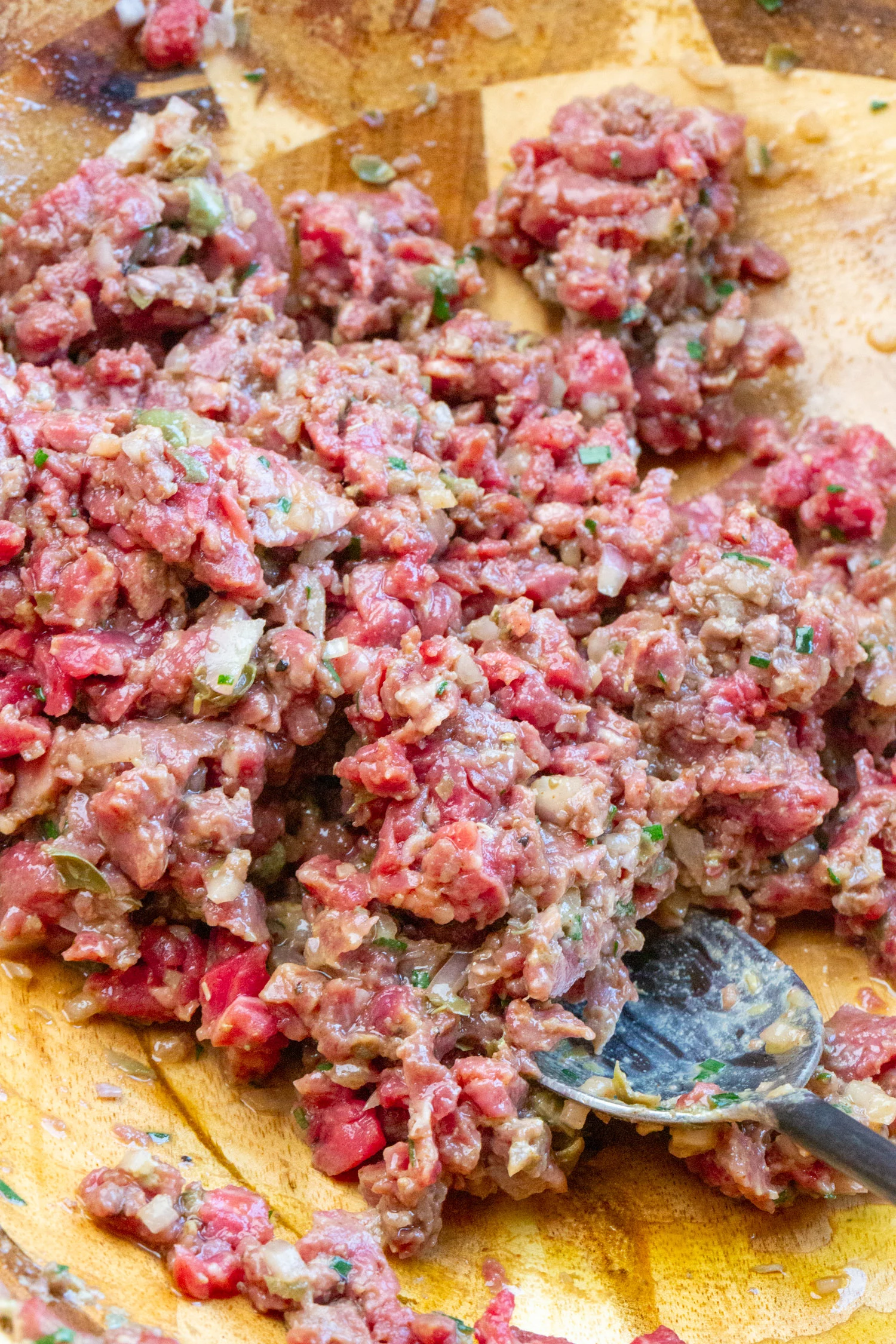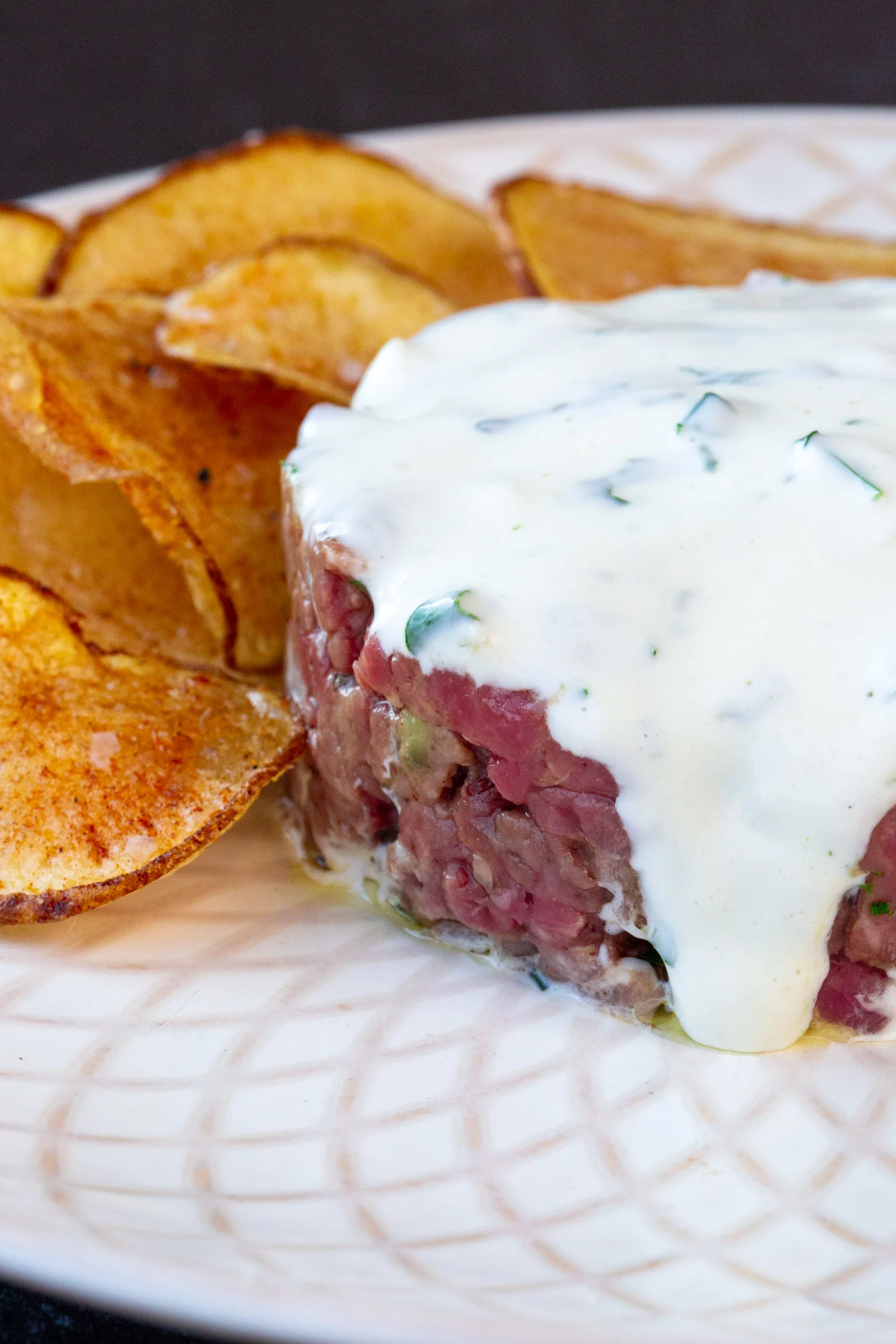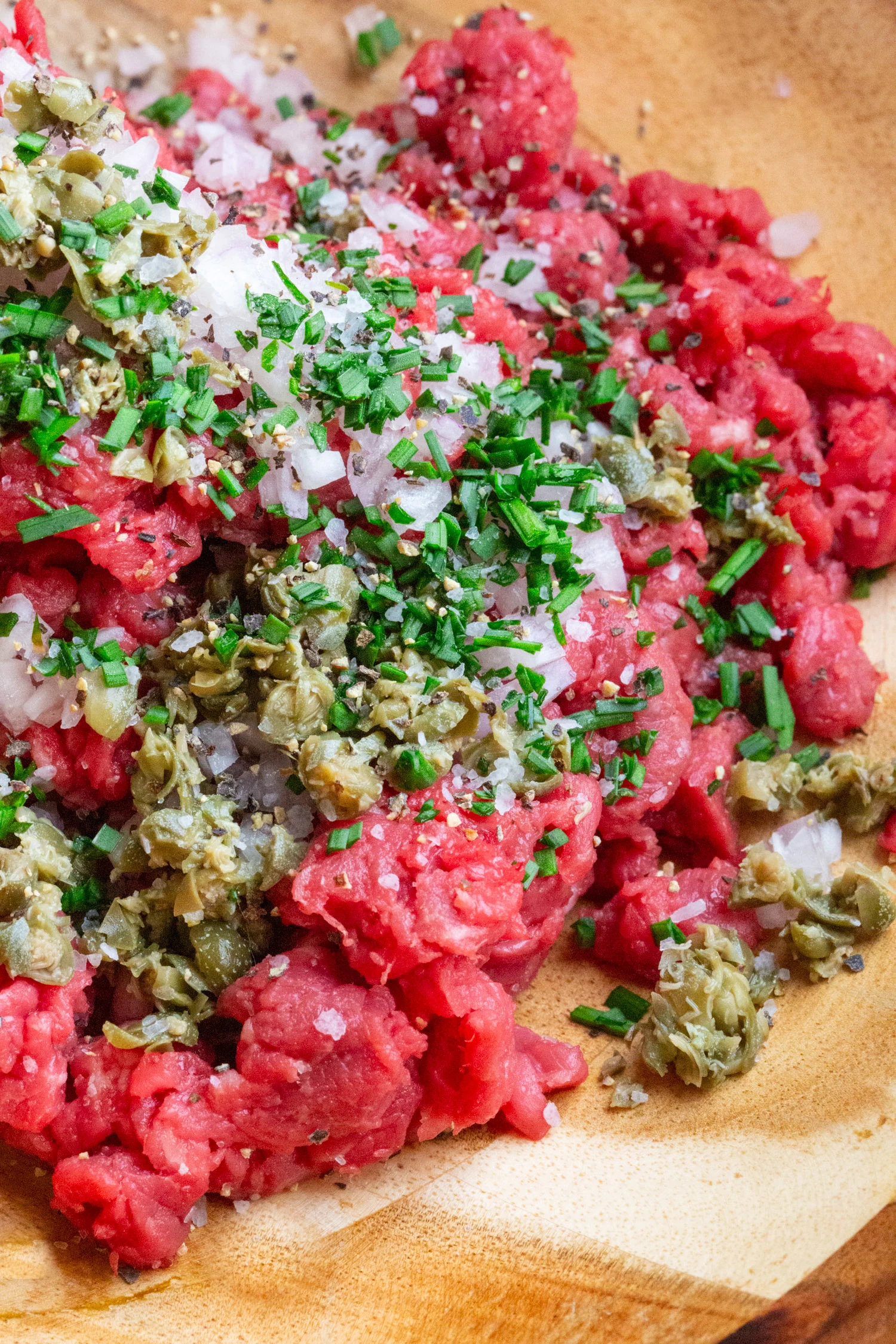In the foodie world, there exists a delicacy that boasts a refined elegance and a daring sense of adventure on the plate – authentic beef tartare.
A dish that may initially raise an eyebrow or two, beef tartare represents the epitome of love for excellent quality beef, captivating the palates of serious food lovers.

Prepared with expert craftsmanship, this dish offers a symphony of flavors and textures, taking us on a culinary adventure where every bite is an invitation to savor the finest nuances of unadulterated beef.
Join us as we dive into the world of beef tartare (actual beef tartare recipe here), unmasking its secrets, debunking misconceptions, and uncovering the undeniable allure of this classic steak dish.
Is Beef Tartare Safe To Eat?
Beef tartare, when prepared correctly using fresh, high-quality ingredients, can be enjoyed safely by most adults. However, it is essential to exercise caution and adhere to certain guidelines to minimize any potential health risks associated with consuming raw or undercooked meat.
The safety of beef tartare largely depends on the quality of the beef and the sanitation practices employed during its preparation. Using fresh, properly handled, and preferably organic or grass-fed beef is crucial. These factors help reduce the risk of bacterial contamination, such as E. coli or salmonella in rare steak.
To ensure safety, professional chefs and home cooks follow strict protocols when making beef tartare…
This typically involves selecting whole cuts of beef, which are then meticulously examined, ensuring the freshest, bright red beef is used.

Additionally, many chefs freeze the meat for a certain period to kill any potential parasites. Finally, the meat is finely chopped and mixed with various seasonings and garnishes, further enhancing the flavors.
The meat is always kept cold and out of the temperature danger zone.
It is important to note that certain individuals, such as pregnant women, young children, the elderly, and those with compromised immune systems, may be more susceptible to foodborne illnesses. Therefore, it is advisable for these individuals to consult their healthcare providers before consuming raw or undercooked meat dishes like beef tartare.
Ultimately, with proper sourcing, careful handling, and strict adherence to food safety practices, beef tartare can be enjoyed as a delectable culinary experience. However, it is always wise to exercise personal discretion and consider individual health circumstances when making dining choices.
If you are in doubt, discuss it beforehand with your physician and never serve any raw meat, including steak tartare to children, pregnant women, or those with compromised immune systems, such as the elderly.
Why Is It Okay to Eat Tartare?
It’s only okay to eat beef tartare or steak tartare when the raw steak is processed, handled and prepared correctly from start to finish.
The risk of foodborne illness, mainly E. coli, is the main negative association with any raw meat or raw ground beef. E. coli comes from the intestines of cows and does not just spontaneously appear in meat out of thin air as many believe.
When a healthy cow is being processed and broken down into different cuts of beef like brisket, tenderloin, and new york strips, it is processed in temperatures less than 50 degrees Fahrenheit. The low temperatures keep harmful bacteria from growing or developing.
During the butchering process, the cow’s intestines can get nicked or cut and when that happens, e. coli has its chance to contaminate the beef from where it resides in the intestines. E. coli bacteria is the prime concern when enjoying raw or undercooked meat, but other bacteria and parasites can also be harmful.
Outside of E. coli being introduced in the butchering process, food poisoning can be minimized as much as possible by keeping the uncooked meat below the temperatures in the danger zone.
The food temperature danger zone is 41 degrees Fahrenheit to 135 degrees Fahrenheit, as taught by ServSafe, the food industry’s educational and licensing body for food safety.
Do not allow your raw cut steak or raw ground steak to come anywhere close to room temperature or the health risks can increase significantly, especially in pregnant women.
As long as the processing, handling, and preparation of your steak tartare are done in accordance with these gold standards taught by culinary schools under the guidance of ServSafe recommendations, you are likely to have a harmless experience with rare steak or beef tartare (outside of whether you like the taste or not).
Though beef tartare is never 100% safe, there are best practices to explore when preparing this dish.

How do I make sure my beef tartare is safe?
These are some of the steps you can take to make sure your beef tartare is safe:
- ONLY buy your beef steak from a reputable butcher or high-end grocery store
- Communicate to your butcher that this will be served raw to assist him in guiding you to the freshest, most appropriate cuts of meat
- Buy whole beef tenderloin and NEVER ground beef
- Refrigerate your beef IMMEDIATELY when you get home
- Wash all surfaces your beef tartare could possibly touch while preparing
- Wash your hands with soap before and use gloves while preparing your steak tartare
- Eat immediately after preparing your tartare
- Only consume beef tartare after getting approval from your doctor
- Do not serve raw meat to children, pregnant women, or the elderly
Only Buy Your Beef Steak from the Most Reputable Butcher or Grocery Store in Your Area
Beef tartare sounds like a scary dish because it is raw meat that you’re preparing, but when you’re educated on the proper preparation to keep it safe and understand the risks, the method itself is quite easy to prepare.
The first thing you must do is buy your whole beef steak at a reputable butcher or a high-quality grocery store.
I go to high end grocery stores such as Central Market or Whole Foods when I prepare raw dishes like tartare because I believe these stores (as well as some reliable butchers) hold themselves to the highest standards during production and also have higher grades of meat. These vendors and butchers are even where some high-end restaurants source their meats.
We prefer meats that are Prime grades because the cows are typically kept in better living conditions. These improved living conditions can drastically decrease the risk of foodborne illness in raw meat dishes as a result of the cows having more healthy immune systems.
Prime grades of meat typically have more flavor in them to excite your taste buds even more!

Buy Whole Beef Tenderloin and NEVER Ground Beef
When buying your beef for your tartare I recommend buying whole beef tenderloin. It is crucial to only buy whole cuts of beef as opposed to ground. You must not use store ground beef tenderloin or any kind of pre-ground meat for tartare.
The reason many chefs use beef tenderloin is that it is the leanest and most tender cut of beef, with virtually no connective tissue. Since we are not cooking steak tartare, the meat will have no chance to break down and become any more tender (like a brisket does over many many hours).
We’re going to use our Japanese chef knife (click here to find out why we use Japanese Knives) to finely chop our steak cuts into tiny morsels, which resemble ground beef, but without the contamination risks.
You should never use ground beef for tartare, because during production ground beef, and ground steak, are made in batches by processing over 100 cows.
This means that if one cow was butchered incorrectly (by a knife knicking an intestine containing e. coli) all of the other meat ground that day is also likely contaminated.
This is the reason you occasionally see recalls on batches of ground beef…because e.coli or another microorganism has been traced back to a production date and all meat from that processing plant is presumed to be contaminated.
When you buy a beef tenderloin, you’re making your tartare recipe with just one cow and therefore limiting your risk of contamination tremendously. Buying whole cuts of meat instead of ground beef is the only way to go.

What kills the bacteria in steak tartare?
If you’re making steak tartare the traditional way a chef prepares it there is nothing that kills the bacteria.
This is a common misconception and myth. There are people out there that say you should boil the raw meat in salted water to kill the bacteria or even sear it on the outside, but again, that is not the traditional or correct way to prepare steak tartare.
Cooking the meat would transform it into another dish, and searing on the outside would not eliminate microorganisms in the interior.
Steak tartare is raw by definition and eating it comes with similar risks as eating Hawaiian poke, real ceviche, sashimi, or sushi.
History of Steak Tartare
Here is a fun history lesson about tartare! Tartare originated in medieval times among warring Mongolian and Turkic tribes known as the Tartars.
They ate raw horse meat because that is what they readily had on hand. ( I know, barf.)
They shredded the raw meat with their knives and did not cook it in any way. It was later adapted into French haute cuisine and other cultures that began adding additional seasonings such as shallot, Worcestershire sauce, and dijon mustard. So there is your fun history fact about tartare meat!
There are some out there who believe beef and steak tartare came about from raw meat being eaten with tartar sauce. But that’s not near as cool as the dish originating from warring medieval tribes.
What meat is safe for beef tartare?
Technically, all of the highest quality, super fresh, whole cuts of beef are equally fine for beef tartare, with the exception of ground beef. That being said, chefs recommend raw beef tenderloin (the cut that filet mignon comes from) because it is lean, tender, and has no connective tissue that would make the experience chewy.
Other cuts of beef may be less tender and have more fat, which in large quantities will mask the flavor and make the dish overly fatty.
The most important thing that relates to the safety of beef tartare is to not use pre ground beef. Using packaged ground beef is the best way to get a foodborne illness such as E. coli, so avoid it and grind the beef yourself with a sharp knife.
We know this very popular dish will only be made on rare occasions and we want those times to be a culinary adventure, not a trip to the ER.
Can you use supermarket beef for tartare?
Yes, you can use supermarket beef for tartare as long as you are shopping at high-quality, high-end grocers or butchers that meet the qualifications recommended for eating raw or undercooked meat.
The store should be clean and fresh, without odors. The meat should be bright red, odorless, and of the highest quality. Only buy whole cuts, never ground beef. The meat should be prepped and handled in chilled climate control environments from start to finish.
Do not instruct the supermarket to grind your steak up in their grinder, because cross-contamination of microorganisms is one of the biggest concerns when enjoying tartare. Chop it yourself with a sharp knife using sanitized home equipment.
Also, consider discussing your intentions with your butcher to receive his recommendations and advice about the meat available that day. People who enjoy raw food diets are well-versed in the basic hygienic rules for handling raw meat, raw eggs, and all other types of raw foods, so their advice should help you make informed decisions.

